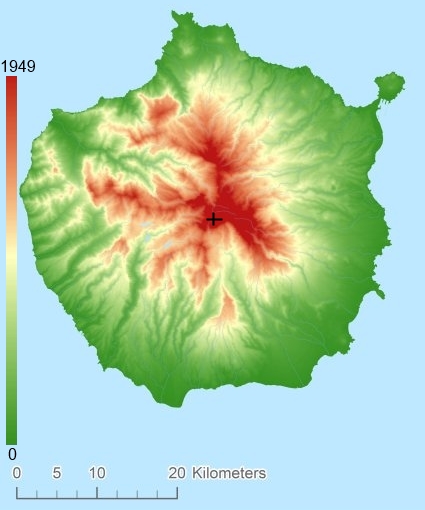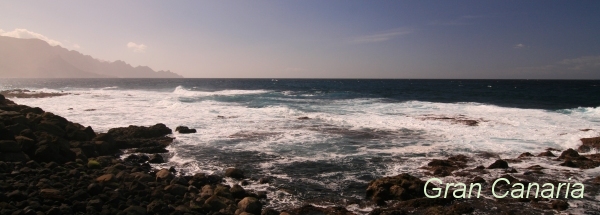Description island Gran CanariaThe inhabited large island of Gran Canaria (local name Isla de Gran Canaria) is part of (the island group) Canary Islands and is located in the country of Spain, Southern Europe. The distance to the mainland is about 223.3 km. The nearest (main) land is Marocco and is not the country to which the island belongs. The surface-area of the island is 1560 km2 and is therefore 4.1 x times greater than the island of Isle of Wight. The island lies in the Atlantic Ocean and the total coastal length is about 244 km and the dimensions of the island are approximately 50 km by 50 km (maximum width). The island has No maindirection-circular. The highest point is 1949 meter and is named Vulkaan Pozo de las Nieves. The coordinates (latitude, longitude) of the island (center) for GPS are 27.95 (27°57'1.6002), -15.59 (-15°35'36.8412).The population is 850391 and the population density is thus on 545.00 inhabitants per square kilometer (compared Isle of Wight 364 inhabitants / km²). The capital of the island is Las Palmas de Gran Canaria (located in the North-northeast of the island). Other places on the island are: Santa Lucía de Tirajana (OZO). The island is located in the Southwest of the country Spain. It is located in the administrative unit Autonomous Community Canary Islands (local administrative level-name Comunidad autónoma), in the Province Las Palmas (local administrative level-name Provincia). Direct neighboring islands of Gran Canaria are (distance from central part island to central part of the neighboring islands): 1) Tenerife Located 57.6 km SouthEast of the island. 2) Fuerteventura Located 84.6 km North of the island. 3) La Gomera Located 125.1 km South of the island. 4) Isla de Lobos Located 166.4 km NorthNorthEast of the island. 5) Lanzarote Located 167.7 km NorthNorthEast of the island. 6) La Palma Located 199.8 km SouthSouthEast of the island. 7) El Hierro Located 202.1 km South of the island. 8) Graciosa Located 215.5 km NorthEast of the island. 9) Montaña Clara Located 220.1 km NorthEast of the island. 10) Alegranza Located 227 km NorthEast of the island. 11) Ilhas Desertas Located 475.2 km East of the island. 12) Ilhas Desertas Located 483.5 km East of the island. 13) Ilhas Desertas Located 495.4 km East of the island. 14) Madeira Located 507.5 km EastSouthEast of the island. 15) Perejil Island Located 1273.4 km NorthEast of the island. 16) Santa Maria Located 1305.6 km SouthEast of the island. 17) Peñon de Vélez de la Gomera Located 1306.1 km NorthEast of the island. 18) Peñon de Alhucemas Located 1340 km NorthEast of the island. 19) São Miguel Located 1380.4 km SouthEast of the island. 20) Ilhéu de Vila Franca Located 1393.8 km SouthEast of the island. 21) Isla de Alboran Located 1448.8 km NorthEast of the island. 22) Isla del Congreso Located 1451.7 km NorthEast of the island. 23) Isla de Isabel II Located 1452.9 km NorthEast of the island. 24) Isla del Rey Located 1453.5 km NorthEast of the island. 25) Terceira Located 1568.6 km SouthEast of the island. Note: The information described below is partly subject to change. The island is directly accessible from Western Europe by plane. There is a ferry connection for cars to the mainland. For pedestrians, there is a ferry connection to the mainland also. Far as is known, there are good cycling opportunities on the island. The source material on the island consists of vulcanic. The land use on the island of Gran Canaria consists of Sand - Rock 17.5 km2 (1%), wood 149.7 km2 (10%), nature 862.6 km2 (55%), and agriculture 376.2 km2 (24%), Special is that the island also prevent vineyards (32.1 km2 - 2%). To return to the overview page of this island click on the following link: Overview island Gran Canaria |
Topographic islandmap Gran Canaria © OpenStreetMap-auteurs, CC-BY-SA. Map Gran Canaria Gran Canaria views: 1054 Height map of Gran Canaria |



